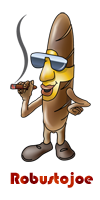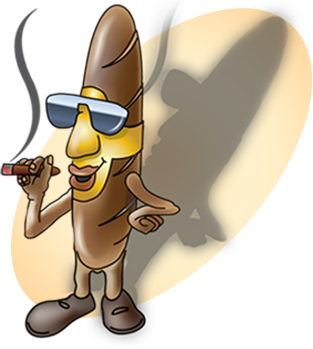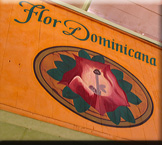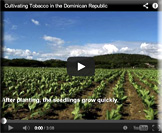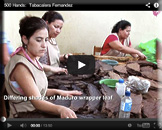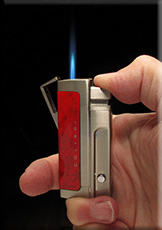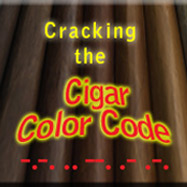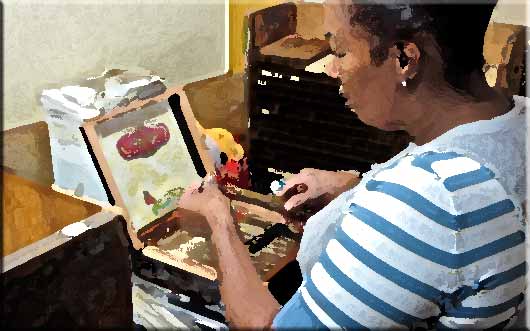
In Parts One and Two, we toured the factories of Davidoff, Matasa, La Flor Dominicana, and Aging Room. At each stop, we sampled cigars of extraordinary flavor and strength. Again and again, my preconception of Dominican cigars had been challenged. In the case of LFD and Aging Room, strength was augmented by a spicy quality I had never before tasted in cigars from DR. But spiciness is a flavor most associated with tobacco from Esteli, Nicaragua. How did LFD and Aging Room pull this off? A trip to a tobacco field would make things clearer.
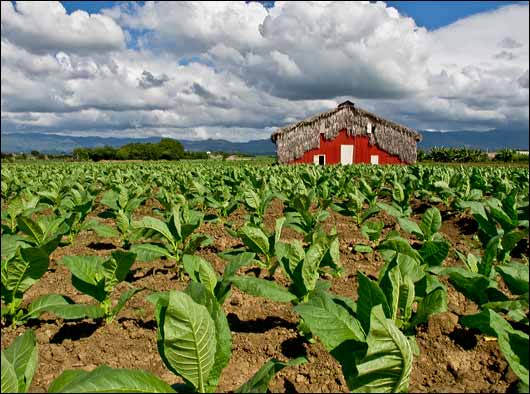
Yaque Valley, DR
A Field of Dreams.
With a planned visit to a tobacco farm, our last day in DR promised to be a memorable one. Prior to this, I had only seen pictures of tobacco fields. Soon I would be walking among tobacco plants as tall as my shoulders.
With the morning air damp with dew, we loaded into a minivan and drove down the hill from Camp David. Our route to the fields took us through town, and into the farming communities that surround Santiago. As we drove, the city gradually gave way to rolling hills and rice paddies. Within a half hour, we were in the fertile Yaque Valley. It is here where the best Dominican tobacco is grown.
Turning off the two-lane blacktop, our van kicked up clouds of dust as we rumbled toward the fields. As we got closer I could see acre upon acre of manicured tobacco plants. It was an exhilarating sight. Against the blue sky and white clouds, the plants looked a gorgeous deep green. Up close, I could see the enormity of the tobacco leaves. Some were as long as my arm. The biggest surprise came upon touching the huge tobacco leaves. Unlike anything this city boy had felt, the leaves had a rough texture. Almost like thick sandpaper. And each perfectly shaped leaf was sticky to the touch. It was obvious that these plants were expertly maintained. Every leaf was perfectly blemish free. In the cigar business, the more perfect the leaf, the better the cigar. It’s like growing money.
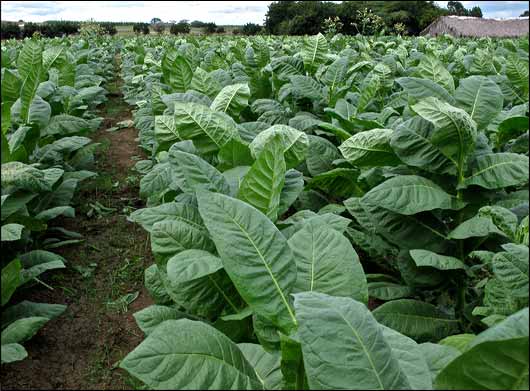
Dark soil of the Yaque Valley.
But something I noticed struck me in a profound way; the soil color. It was very dark. The last time I had seen soil like this was in Esteli, Nicaragua. The similarity suggested a notion: the nutrients in dark soil, albeit in Esteli or the Yaque Valley, must be a key factor in growing spicy tobacco. We were standing in the fields that serviced both LFD and Aging Room; two brands known for spicy cigars. I’m no geologist, but my simple observations seemed to make sense.
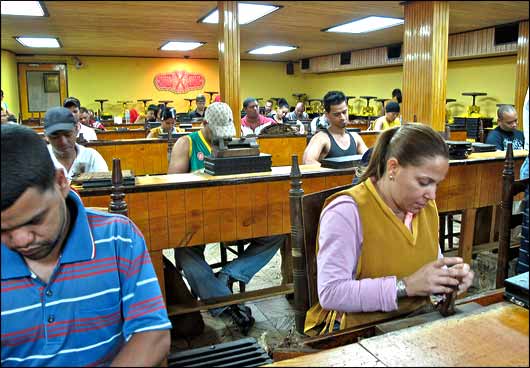
Rolling the Opus X at Fuente.
Finally Fuente.
Our next stop, and the last of the trip, was to the renowned factory of Fuente Cigars. One of the most respected names in all of cigars is that of Arturo Fuente. The father/son cigar making team have been around for decades, and make one of the world’s most popular cigar brands, the Opus X. The Opus X Robusto is one of my favorite cigars, and I was looking forward to seeing its birthplace.
Located in a gated industrial park, the Fuente factory is comprised of many buildings. We visited the main facility where the rolling, labeling, and packaging were in full swing. Right from the start, this factory tour was different from all the others. Instead of open arms, we were greeted with a warning…don’t take any videos. And, we were told not to take photos of certain “restricted areas”. I didn’t know what that meant, so I took pictures of everything…no one objected. It wasn’t until after the tour that I understood why we were treated with suspicion…more on that later.
Upon entering the facility, I immediately noticed a lack of windows. There was a closed-in feeling at Fuente. The place was well lit, but by artificial lighting. No direct sunlight was allowed to penetrate through the walls. This struck me as odd. Later in the tour while visiting their cold storage room, the guide mentioned that only incandescent lights were allowed there. He said that fluorescent light was bad for cigars…okay. I’d not heard that before. Odd since all the torcedores at the place were working under fluorescent lights. Perhaps long-term storage needs this extra level of care. In the cold room, the lights were kept very low. Just a single bulb burned in the center of the room. It makes sense that light exposure could, over time, bleach delicate cigar wrappers. This made me feel that the guys at Fuente were very particular.
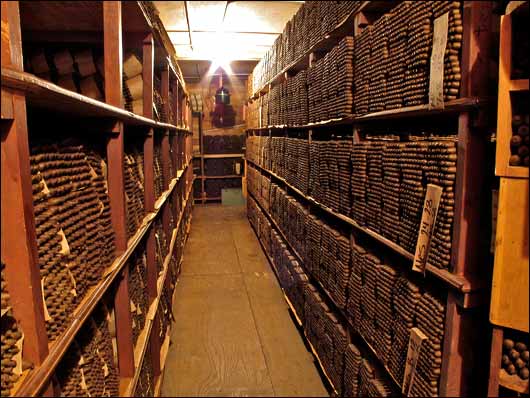
Fuente Hemingway cigars aging in the cold room.
The Fuente tour was also different in that the two major brands were rolled separately and in different rooms…one for the Hemingway line, the other for the Opus X. These cigars were also stored in separate aging rooms. Most factories have a large space where all the rollers work side by side. But the rooms at Fuente were small so it made sense to divide the work by brands.
All in all, the Fuente tour was over very quickly. We were led from rolling to labeling to boxing in about twenty minutes. Questions were discouraged, and there was no sit-down to enjoy cigars over coffee. We were, however, asked which Fuente brands we would like to bring with us. I suggested the Opus X Robusto, and another mentioned the Don Carlos, both great cigars. At the exit, we were handed a bundle of each and told goodbye. It was a disappointing tour. But at least we had some great cigars to smoke on the way home…or so I thought. Upon opening up an Opus X Robusto, I could see right away that these cigars were flawed. Cigars not suited for sale. All the cigars in the bundles had water spots, or uneven caps. I think these cigars were for handouts. But the biggest disappointment came upon lighting. Gone was that great Opus X richness. The cigars tasted like straw. Perhaps these had dried out and then rehydrated. The cigars themselves were not brittle, just tasteless.
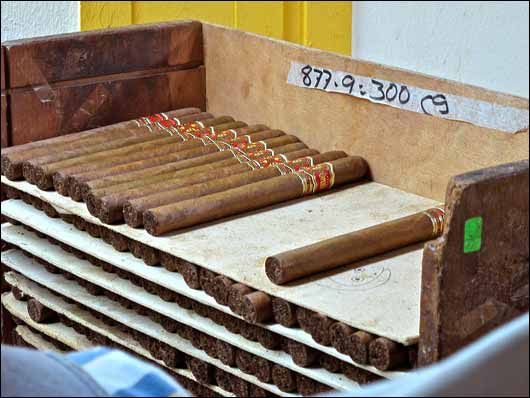
Opus X before boxing.
Later that evening, I was told something that put the Fuente experience in perspective. During the cigar boom of the early decade, Fuente had many of its workers lured way by competitors. Cigar rolling is a craft that requires years of training. That is a commitment of resources that each cigar company must make in order to survive. For Fuente to train hundreds of rollers, only to have them “stolen”, seems to have left the company suspicious of outsiders. This would explain the “no video” policy, as well as the truncated tour. It is interesting that the one company I was most interested in visiting while in DR, turned out to be the most disappointing.
The “new” DR.
With the trip now drawing to a close, it was time to reflect on what I had experienced.
Over the last fifteen years, cigar manufacturing has evolved faster than any other time in history. The proliferation of Nicaraguan tobacco has given rise to new cigar flavors and increased cigar potency. This, in turn, has molded cigar smoker’s tastes and expectations. We now crave bolder blends, with complexity unlike any cigars of the prior decade. This has put Nicaragua in the forefront. Not to be outdone, it looks like the cigar makers in DR have made a conscious effort to meet the demand for bold flavor head on. The result, as I could see first hand, is a flavor profile that had never existed before. The tobacco grown in DR has a brighter flavor than that grown in Nicaragua. It’s herbal, rather than earthy, and offers a spicy quality that is unique to the island. Now every bit as strong as its Nicaraguan counterparts, the new flavor of DR offers the experienced cigar smoker an alternative. Where I once sought out Nicaraguan puros, I now reach for the bright complexity that only comes with a 100% Dominican cigar. I like traditional, Cuban-like flavors, and the new generation of Dominican puros provides that with enhanced flavor and spice.
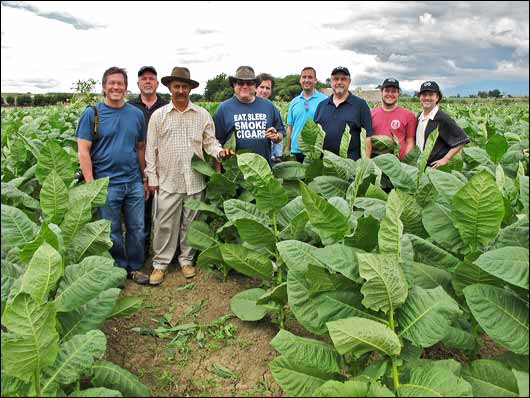
The Gang.
This trip really turned my cigar world upside down. With perceptions challenged, and new friends made, my journey to Santiago, DR offered a unique look into the world of cigar making. If you get a chance, I encourage ALL cigar lovers to visit DR. It’s a magical place where passion and commitment work together to create the best cigars on the planet. And where innovation gives rise to invention. The New Face of Dominican Cigars is one of bold flavors, and inspiration. It can be seen in the smiles of everyone involved in the great cigar industry of the Dominican Republic.
Thanks for listening,
Joe
PS…if you want to take the journey yourself, you can do so by contacting Colin Ganley at CigarTourism.com.
